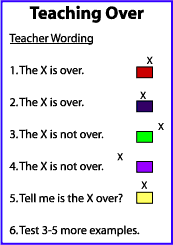Vocabulary

Teaching Strategies and Examples: Oral Vocabulary Teaching Strategies
Simplifying Direct Vocabulary Instruction: Matching Instruction to Your Goal
- There are a limited number of ways to teach vocabulary directly!
- The way you teach depends on learner knowledge and what you want students to be able to do.
- Three Prominent Oral Vocabulary Teaching Strategies:
| Modeling (Examples): | |
| When it is impossible to use language to explain the meaning of a word (e.g., between, in). | |
| Synonyms: | |
| When a student knows a word(s) that can explain the meaning of a new, unknown word (e.g., damp means a little wet). | |
| Definitions: | |
| When students have adequate language to understand a longer explanation and when the concept is too complicated to be explained through a synonym (e.g., service station is a place where gasoline is sold and cars are repaired). | |

Modeling
- Model positive and negative examples of the new concept. (e.g., "This is a mitten." or "This is not a mitten.").
- Test student on their mastery of the examples (e.g., "Is this a mitten or not a mitten?").
- Present different examples of the new word along with examples of other previously taught words. Ask for names (e.g., "What is this?", "What color is this?" or "Tell me how I'm writing.").
Examples of Content Teaching
 |
 |
 |

Synonyms
- Teacher equates a new word (sturdy) with a known word(s) (strong). (e.g., "Here is a new word. Sturdy. Sturdy means strong.").
- Teacher tests a set of positive and negative examples for the new word. (e.g., "Tell me sturdy or not sturdy.").
- Teacher provides practice in applying several recently taught synonyms. (e.g., "Is that sturdy? Is it tidy? Is it mild?").
When Teaching Synonyms
- Use words students know
- Test on a range of positive and negative examples
- Huge means very big.
- What does huge mean?
- Tom put his pet in his pocket. Was his pet huge?
- The animal wouldn't fit through the door. Was the animal huge?

Definitions
- Teacher tells the students the definition and has them repeat it. (e.g., "An exit is a door that leads out of a building. What is an exit?").
- Teacher tests the students on positive and negative examples to ensure that the students understand the definition and that they are not just memorizing a series of words. ("Is this an exit or not an exit? How do you know?").
- Teacher provides a review of previous words. ("What is this? How do you know?").

The Way You Teach Vocabulary Depends on Your Goal
Kindergarten Standard: Identify Common Words and Sort in Basic Categories (colors, shapes, foods)
- Other examples of categories: animals, position words, clothing
Use concept teaching (modeling) when children have limited language and explanations contain words children do not understand.
Features of Concept Teaching (Modeling):
- Set up (use the same material and vary only the dimension that changes it from the concept to not the concept).
- Show a range of positive and negative examples
- Include negative examples that are minimally different
- Keep language consistent